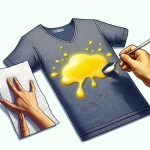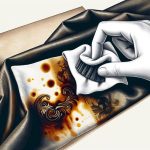You want to know how to remove shea butter stains from fabrics.
Here are 5 effective methods for tackling this common problem:
- Using dish soap and warm water
- Applying cornstarch or talcum powder
- Treating with white vinegar
- Using a grease-fighting laundry detergent
- Enlisting the power of enzyme-based stain removers
These methods are practical and can be easily incorporated into your regular laundry routine.
By following these techniques, you can master the art of removing shea butter stains from your favorite fabrics, ensuring they stay clean and fresh for years to come.
Key Takeaways
- Dish soap and warm water can be effective in removing shea butter stains.
- Cornstarch or talcum powder can absorb oils and fats from shea butter and aid in stain removal.
- White vinegar can be used to treat shea butter stains by dabbing it onto the stain and rinsing with cold water.
- Enzyme-based stain removers are powerful in breaking down and removing shea butter stains from fabrics.
Using Dish Soap and Warm Water
To remove shea butter stains from fabrics, begin by mixing dish soap and warm water in a small bowl. This simple yet effective method can help tackle the greasy residue left behind by shea butter.
Once you have the solution ready, gently dab at the stained area with a clean cloth or sponge. Avoid rubbing vigorously, as this can spread the stain further. After blotting the stain, rinse the fabric with warm water.
If the stain persists, you may consider using a mild detergent directly on the affected area before rinsing again. For stubborn stains, a heat treatment can be applied by washing the fabric in the hottest water safe for the material.
Additionally, fabric softeners can be used in the wash to help break down and remove the shea butter stain.
Following these steps can aid in effectively eliminating shea butter stains from your fabrics, restoring them to their pristine condition.
Applying Cornstarch or Talcum Powder
Applying cornstarch or talcum powder can help in absorbing and lifting shea butter stains from fabrics. Here are some key points to consider when using these natural alternatives:
- Absorption: Cornstarch or talcum powder work by absorbing the oils and fats from the shea butter, making it easier to lift the stain from the fabric fibers.
- Ensure that the stained area is completely dry before applying the cornstarch or talcum powder to allow for maximum absorption.
- Gently press the powder onto the stained area and let it sit for at least 15-20 minutes to absorb the oils from the shea butter.
- Fabric Compatibility: These natural alternatives are generally safe to use on most fabric types, but it's essential to test them on a small, inconspicuous area of the fabric first to ensure they won't cause any discoloration or damage.
- If the fabric shows any adverse reactions to the cornstarch or talcum powder, refrain from using them and consider alternative stain removal methods.
Utilizing cornstarch or talcum powder can be an effective and gentle way to tackle shea butter stains on fabrics, providing a natural and fabric-friendly solution for stain removal.
Treating With White Vinegar
How can you effectively utilize white vinegar to treat shea butter stains on fabrics?
White vinegar is a versatile and effective option for treating shea butter stains on fabrics. To begin, mix one tablespoon of white vinegar with two cups of cool water. Dab the solution onto the stained area using a clean cloth, working from the outside of the stain towards the center to prevent spreading. Let the vinegar solution sit on the fabric for 15 minutes before rinsing with cold water. For tougher stains, you can also add a small amount of liquid dish soap to the vinegar solution for extra cleaning power.
When using white vinegar to treat shea butter stains, it's important to test the solution on a small, inconspicuous area of the fabric first to ensure fabric compatibility. If the fabric isn't compatible with white vinegar, consider using alternatives such as lemon juice or hydrogen peroxide. Additionally, always remember to blot the fabric gently to avoid damaging the fibers.
With proper application and attention to fabric compatibility, white vinegar can be an effective solution for removing shea butter stains from fabrics.
Using a Grease-Fighting Laundry Detergent
You can effectively remove shea butter stains from fabrics by using a grease-fighting laundry detergent. When dealing with oil stains, it's crucial to use the right products and techniques for successful removal. Here's how to use a grease-fighting laundry detergent to tackle shea butter stains:
- Apply the detergent directly to the stained area: Gently rub a small amount of the grease-fighting laundry detergent onto the shea butter stain. Ensure that the detergent covers the entire affected area.
- Let it sit for a few minutes: Allow the detergent to penetrate the fabric and break down the oils in the shea butter stain. This step is essential for loosening the stain from the fabric fibers.
- Wash the fabric as usual: After pre-treating the shea butter stain with the grease-fighting laundry detergent, launder the fabric according to the care instructions. Use the hottest water temperature recommended for the specific fabric to help lift the stain effectively.
Using a grease-fighting laundry detergent is a practical and efficient method for addressing shea butter stains on fabrics. Following these laundry care tips can help ensure successful oil stain removal from your garments.
Enlisting the Power of Enzyme-Based Stain Removers
To further combat stubborn shea butter stains on fabrics, let the power of enzyme-based stain removers work their magic. Enzyme-based cleaners are highly effective in breaking down organic stains like shea butter. These cleaners contain enzymes that target and break apart the molecules causing the stain, making it easier to lift off the fabric. When dealing with tough shea butter stains, using an enzyme-based detergent can significantly improve the stain removal process. These detergents contain powerful enzymes that can penetrate deep into the fabric to break down and remove the stubborn shea butter residue.
Here's a table outlining the benefits of using enzyme-based stain removers for fabric stain removal:
| Benefits of Enzyme-Based Stain Removers |
|---|
| Effective at breaking down organic stains |
| Penetrates deep into fabric for thorough cleaning |
| Helps lift stubborn shea butter stains off fabrics |
Enzyme-based stain removers are also ideal for pre-treating stubborn shea butter stains before washing. Applying the stain remover directly to the affected area and allowing it to sit for a few minutes can enhance the effectiveness of the stain removal process.
Frequently Asked Questions
Can Shea Butter Stains Be Removed From Delicate Fabrics Such as Silk or Wool?
Yes, shea butter stains can be removed from delicate fabrics like silk or wool. Use a gentle cleaning solution and blot the stain, avoiding rubbing. For silk care, consider professional dry cleaning. To preserve wool, use a mild detergent and cold water.
Are There Any Alternative Methods to Remove Shea Butter Stains That Do Not Involve Using Household Items?
For professional services, seek specialized treatments to remove shea butter stains. Consider professional advice for delicate fabrics. Natural remedies may also help, but always prioritize the fabric's care instructions and seek expert assistance if unsure.
Will Applying Heat to the Stained Area Help to Remove the Shea Butter Stain More Effectively?
Applying heat can enhance the effectiveness of shea butter stain removal. Heat helps to loosen the stain from fabric fibers, making it easier to lift away. Use caution with heat sources to avoid damaging the fabric.
Can Shea Butter Stains Be Removed From Colored Fabrics Without Causing Discoloration or Fading?
Yes, shea butter stains can be removed from colored fabrics without causing discoloration or fading. Color safe stain removal and fabric care techniques, such as using gentle detergents and cold water, are effective in preserving fabric color and texture.
Are There Any Specific Precautions to Take When Using Enzyme-Based Stain Removers on Shea Butter Stains?
When using enzyme-based stain removers on shea butter stains, take precautions such as testing on a small, hidden area first to avoid potential damage. Consider the effectiveness of chemical versus natural alternatives for best results.
- Why Open-Weave Scrim Is the Secret to Stunning Event and Canopy Designs - June 26, 2025
- Creating Large-Scale Art Installations With Scrim Fabric - June 26, 2025
- Scrim Fabric in Upholstery: Understanding Its Use as a Backing Material - June 26, 2025







